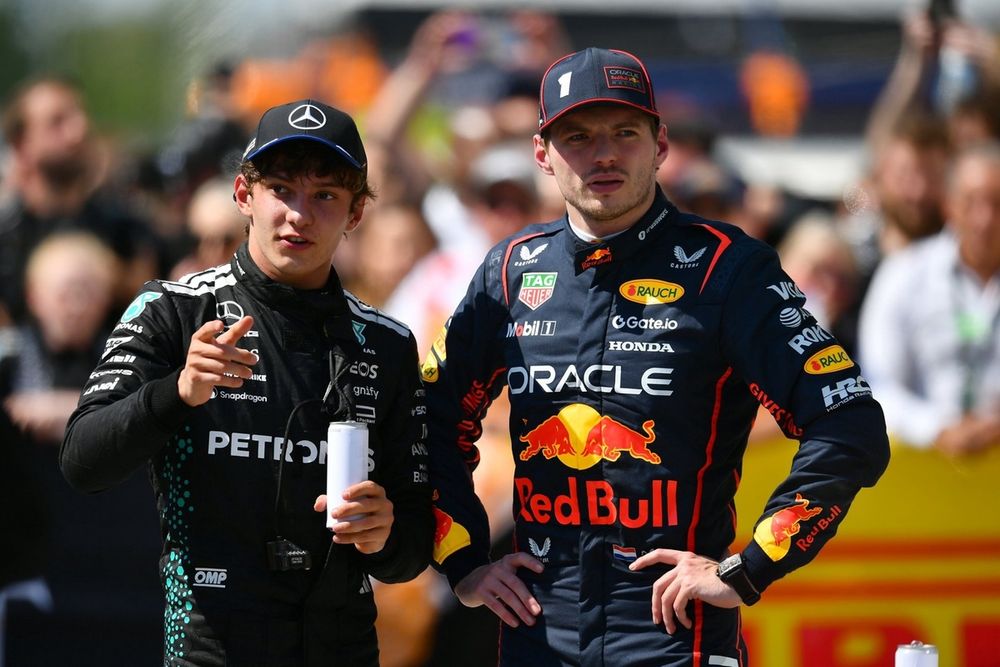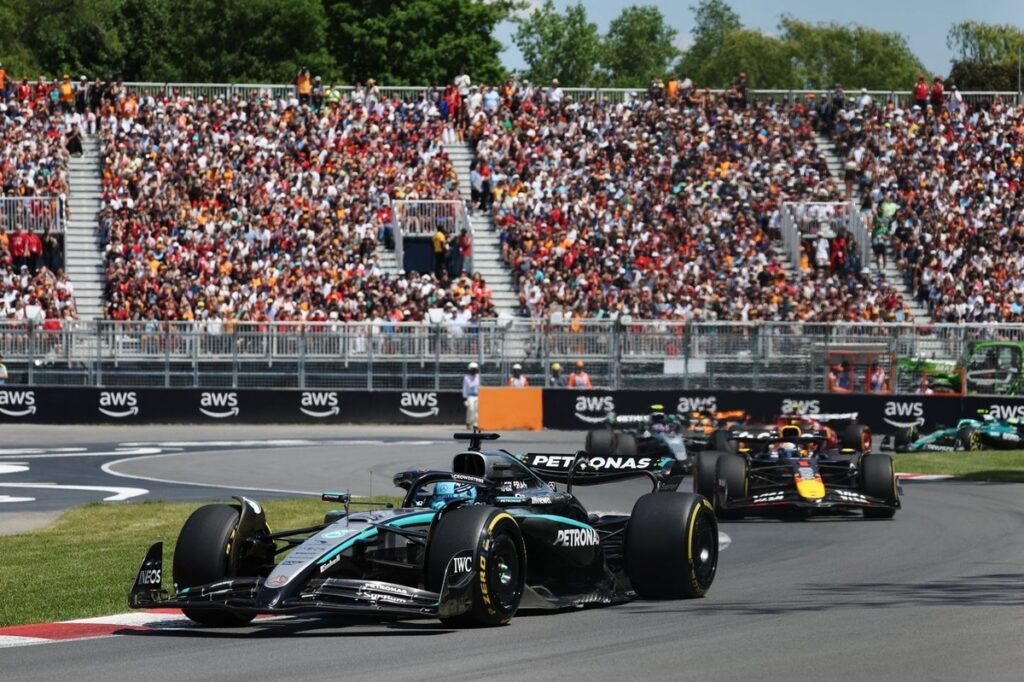“They are faster, so I’m not even thinking about that,” said Max Verstappen during the Canadian Grand Prix media day when asked whether victory was on the cards.
By “they,” the reigning Formula 1 world champion was referring to McLaren as, like many, the Dutchman was predicting another win from the papaya-coloured team and thought he would be left scrapping for the final podium place against Mercedes.
In practice, two elements of his prediction were true: yes, the race became a battle with Mercedes, and yes, it was indeed for a podium place. But it unexpectedly was the fight for the top step of the podium, as McLaren was not as strong as anticipated.
While the race pace of Lando Norris and Oscar Piastri was still slightly better — particularly in the final stint — it wasn’t enough to easily move forward and surpass a charging Mercedes.
Red Bull’s tyre wear higher than expected
Looking back at Friday’s long runs, a similar pattern emerges: one aspect carried over into the race, while two did not.
Max Verstappen, Red Bull Racing
Photo by: Sam Bloxham / Motorsport Images
Data showed that McLaren, Red Bull (well, Verstappen), and Mercedes were closer together than during most race weekends so far this season. It was visible in the race as well, especially in the final stint.
However, not everything went as expected. Mercedes managed its Pirelli tyres significantly better than anticipated, especially as Sunday turned out to be sunnier and warmer than the days before.
“Normally, if I’m wearing a pullover, there’s a correlation with our performances! But today, the track temperatures exceeded 50 degrees and we were still dominant,” said Mercedes boss Toto Wolff. The Austrian credited, among other things, the new rear suspension for the success.
While Mercedes kept its tyres alive longer than expected, the opposite was true for Red Bull. The team was slightly slower than McLaren on Friday but showed encouraging signs regarding the tyre degradation per lap. But the picture changed on Sunday, much to the surprise of Red Bull.
“Our tyre wear was surprisingly high,” Red Bull advisor Helmut Marko admitted. “I think Max pushed a bit too hard in the first stints to keep up with Russell. But the biggest surprise came from Mercedes. They were really quick in the race and didn’t have the tyre issues that we expected.”
Both factors shaped the race, of which Verstappen said: “We drove both an attacking and defending race. The strategy was offensive, but on track I had to spend most of my time looking in the mirrors.”

Max Verstappen, Red Bull Racing, Andrea Kimi Antonelli, Mercedes
Photo by: James Sutton / Motorsport Images via Getty Images
The four-time champion added that he lacked the outright pace to go for the win, and said: “I couldn’t attack at all, not a chance. It was more about damage limitation and trying not to overdo things. We’re still lacking.”
Team radio revelations
While Verstappen called the strategy attacking — with two undercuts — that approach was arguably more defensive in nature. The early pitstops were primarily to protect Verstappen from the advancing Andrea Kimi Antonelli, who closed in rapidly at the end of the first two stints.
In a direct duel, Verstappen would be vulnerable on worn tyres, prompting Red Bull to pull the trigger early. Yes, undercuts are typically offensive moves, but in this case, they were used to keep Antonelli at bay.
At the end of lap 12 — just before Verstappen dove into the pits — Antonelli was nearly alongside the Dutchman on the long straight and graining was already visible on Verstappen’s front-left tyre. Red Bull’s undercut to retain second was effective, as Verstappen rejoined with a 2.5-second gap to Antonelli.
It’s worth noting that the rookie couldn’t react immediately. The first car on track naturally gets the better strategy, meaning Mercedes pitted Russell a lap after Verstappen to defend. Antonelli had to stay out longer, losing those 2.5 seconds over two laps on older rubber.
That time loss was minimal, and foreshadowed the second round of pitstops, when Antonelli could respond the very next lap. But the same pattern repeated: Verstappen pulled away at the beginning of the stint, and Antonelli closed in as Verstappen’s tyres degraded faster than the Mercedes. The 18-year-old even nearly made an overcut work.
Verstappen pitted at the end of lap 37 with 0.8 seconds in hand. As the team radio showed, it was a late call, and again, clearly based on Antonelli. “Box, box, Max,” came the call, to which Verstappen replied, “I’m in,” confirming he had just managed to react in time. Upon exiting the pit lane, Verstappen was immediately told: “Antonelli pace 15.4.”
Andrea Kimi Antonelli, Mercedes
Photo by: Sam Bagnall / Motorsport Images
The next radio message was: “Okay, Antonelli in pit lane. It will be close, so press the overtake button.” Verstappen complied on the long straight, and exiting the first corner, it indeed turned out to be close.
“Racing Antonelli, Max.” The Mercedes driver was actually slightly ahead coming out of the pits, but with warmer tyres and the inside line, Verstappen managed to retain position. It underlined once again that Red Bull was primarily defending – and defending successfully – with its undercut strategy.
A title fight after all? Verstappen isn’t convinced
The calls in Canada highlights two things. First, that Mercedes was better on tyres than Red Bull — although Marko implied Verstappen might’ve pushed too hard in the opening stints. That’s understandable early on, as the Dutchman aimed for victory and the extent of his tyre wear was still unclear at the start.
But in the final stint, Verstappen changed his approach, including a subtle hint from Gianpiero Lambiase on the radio: “Middle stint was 25 laps, Max, now we are looking for 33.”
After the race, Verstappen acknowledged that he feared the final stint might have been too long, but it went better than expected. Part of it was down to his more measured approach, but Verstappen also pointed out another factor: Red Bull’s car performed better as it got lighter.
“Yes, thankfully. I think it was better with a bit less fuel, but even then, I couldn’t attack at all.” Antonelli, for his part, admitted to doing the opposite in the final stint and regretted it: “I pushed too hard behind Max early on and got a bit too greedy.”
In the end, Verstappen achieved the maximum with his P2 finish. The strategy was key to his success, and meant that he gained ground on both McLaren drivers: six points on Piastri and 18 on Norris. However, this doesn’t mean Verstappen believes he’s back in the title fight.
“I think we still need more pace for that. Today, we only finished ahead because of our qualifying and because the team made the right strategic calls,” he said.
“But you can’t always rely on that. We need pure pace. I think McLaren was also a bit weaker than usual this weekend — normally, they are well ahead. Of course, we take all the positives, but we have a lot of work to do if we really want to fight for the championship.”
In this article
Ronald Vording
Formula 1
Max Verstappen
Red Bull Racing
Be the first to know and subscribe for real-time news email updates on these topics
Subscribe to news alerts
Read the full article here

